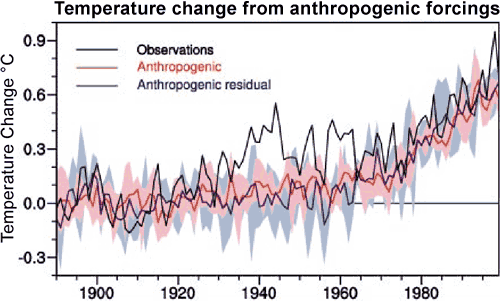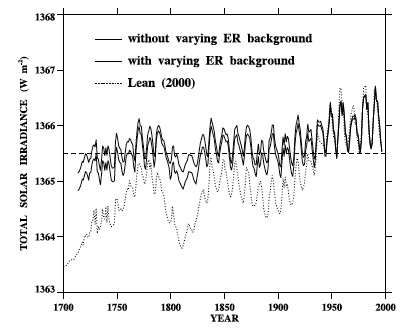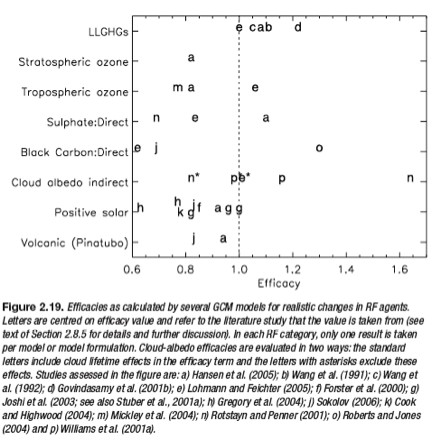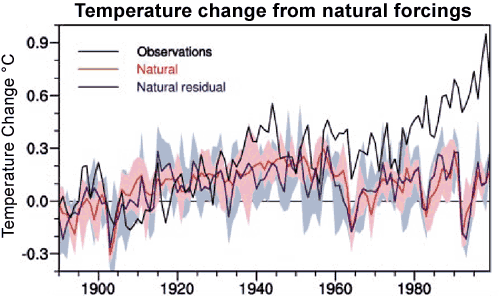Pre-1940 Warming Causes and Logic
Posted on 21 March 2011 by dana1981
We've previously examined the mid-century cooling, but another common "skeptic" argument is that the early 20th Century warming proves that the current global warming could be natural. Although there was a significant increase in global temperature in the early 20th Century, the rate of warming from 1910 to 1940 was lower than the rate of warming from 1975 to 2005, at about 1.3 vs. 1.8°C per century, respectively. That being said, it's worth taking a look at what caused the early century warming. Several different factors contributed.
Carbon Dioxide
Although humans were not burning very large amounts of fossil fuels or emitting large amounts of carbon dioxide (CO2) in the early 20th Century, relative to the late century, CO2 emissions were non-negligible and did play a role in the early century warming.
From 1900 to 1940, atmospheric CO2 levels increased from approximately 295 to 310 parts per million by volume (ppmv). The equilibrium temperature change caused by this increase in CO2 is the climate sensitivity (λ) multiplied by the radiative forcing, which is approximately 5.35 times the natural log of the change in CO2 (Myhre 1998):
The best estimate for the climate sensitivity parameter is 0.8 (Wm-2K-1). Thus at equilibrium, this CO2 change would be expected to cause a 0.22°C increase in the average global surface air temperature.
Meehl et al. (2004) plots the estimated anthropogenic contribution to temperature change in Figure 1 below. Most of the anthropogenic influence comes from CO2.

Figure 1: Climate model results from anthropogenic forcings compared to observations (black line). The red line is the average of the four-member ensemble. The pink shading is the model range. The blue line is the ensemble mean and the light blue shading is the ensemble range.
As you can see, the best estimate of the anthropogenic contribution to the 1910-1940 warming is approximately 0.1 to 0.15°C. This is smaller than the value we calculated above because the planet is not immediately in equilibrium. Much of the energy imbalance goes into the oceans, causing what's known as the "ocean lag" due to the thermal inertia of the oceans. The same lag effect applies to natural forcings.
Solar
The solar radiative forcing is the change in total solar irradiance (TSI) in Watts per square meter (Wm-2) divided by 4 to account for spherical geometry, and multiplied by 0.7 to account for planetary albedo (Meehl 2002). The albedo factor is due to the fact that the planet reflects approximately 30% of the incoming solar radiation. As with CO2, we calculate the equilibrium temperature change by multiplying the radiative forcing by the climate sensitivity parameter.
Wang, Lean, and Sheeley (2005) compared a flux transport model with geomagnetic activity and cosmogenic isotope records and to derive a reconstruction of TSI since 1713 (Figure 2).

Figure 2: Total Solar Irradiance from 1713 to 1996 (Wang 2005)
As you can see, in the early 20th Century, from about 1900 to 1940 there was an increase in TSI from about 1365.5 to 1366 Wm-2, which we can plug into the formula above. However, previous studies have estimated a TSI change as large as 2 Wm-2, so we'll estimate the change at 1 Wm-2. We then only need the solar climate sensitivity parameter.
The climate response to different radiative forcings is similar, but not identical. This is known as the "efficacy" of a radiative forcing. According to various studies of the direct solar forcing efficacy (from TSI alone), as summarized by the IPCC (Figure 3), it is likely smaller than the CO2 efficacy.

Figure 3: Efficacies of various radiative forcings as calculated in numerous different studies (IPCC 2007)
However, since there may be indirect solar effects not accounted for in the direct solar radiative forcing calculation, we'll conservatively estimate the solar climate sensitivity parameter as equal to the CO2 climate sensitivity of 0.8 (Wm-2K-1). Thus at equilibrium, the solar change would be expected to cause a 0.15°C increase in the average global surface air temperature. Simlar to the anthropogenic contribution, the best estimate of the solar contribution to the 1910-1940 warming in Meehl (2004) is approximately 0.1 to 0.15°C (Figure 4).

Figure 4: Climate model results from the solar forcing compared to observations (black line).
Other Forcings
CO2 and the Sun played the largest roles in the early century warming, but other factors played a part as well. For example, human aerosol emissions caused a slight cooling, ozone and other greenhouse gases caused a slight warming, low volcanic activity resulted in a slight warming, and natural cycles like the Atlantic Multidecadal Oscillation (AMO) may have contributed to the warming as well (Tett et al 2002). Meehl (2004) plots the net natural contribution to the warming in Figure 5.

Figure 5: Climate model results from all natural forcings compared to observations (black line).
Conclusion
The "skeptic" logic behind this argument is usually that if the early 20th Century warming was as large as the late century warming, and was natural, then the current warming could be natural as well.
Ultimately while natural forcings can account for much of the early 20th Century warming, humans played a role as well. Additionally, the early century warming wasn't as large or rapid as the late century warming, to which these natural factors did not contribute in any significant amount.
But more importantly, we don't assume that the current warming is caused by humans because it's "unprecedented" or faster and larger than previous natural warming events. We know the current warming is anthropogenic because that's what the physical evidence tells us.
NOTE: this post is also the Advanced rebuttal to "It warmed before 1940 when CO2 was low"































 Arguments
Arguments






























And STILL not accounting for the oceanic interdecadal variability, which is a good explanation for the 1940 blip and for part of the 2000's blip as well and this is what the current climate models are not accounting for. The models you cite do not reproduce this blip, and it definitely is a problem. It is NOT just about external forcing You should already be aware of that. Also, using linear relationships for temperature changes (delta T = lambda x delta F) is a gross oversimplification because we KNOW climate is nonlinear (and so are feedbacks). Just because the models do reproduce the last 30 years with the supposed sensitivity combined with human factors doesn't mean they would "know" what actually has happened.
[DB] There is no robust evidence (AFAIK) showing that oceanic cycles affect the global land+sea temperatures, as Tamino thoroughly shows (here and here for starters).

DB, To be fair in your response to Protestant you claimed that Tamino showed that the AMO does not affect the global land-sea temperatures but that's not an accurate statement. Tamino's analysis there isn't great and I had a long drawn out "discussion" with him in the comments section if you'll notice. We agreed to disagree. A better discussion of the AMO is probably here: http://rankexploits.com/musings/2011/the-atlantic-multidecadal-oscillation-and-modern-warming/ and subsequently in the comments. All in all the AMO probably did contribute more to the mid century warmth than people give it credit but that was in addition to the other factors mentioned by Dana. Together they created the 1940s warming.
[DB] Robert, I accede to your judgement on this matter of the AMO. In that the referenced links above also considered other oceanic cycles (and other exogenous factors) that Tamino has studied, like the PDO, my comment was more dealing with overall picture. I have read & re-read your exchanges with Tamino & respect very much both of your opinions. I will also re-read the Rank Exploits post again.
Out of laziness I only referenced a few of the many Tamino posts on cycles. A search of the Open Mind site will reveal those; the rest can be found at the Archives (except for January and February 2010 posts).
It seems that most proxies start climbing at the beginning of the XXth century and even before, and have achieved most of their growth by the 70's. When I compare with Fig 5., doesn't it seem to imply that this growth is essentially natural and not anthropic ?
[DB] You have interpreted the meaning of Fig 5 backwards. Look at it again.
Natural forcings simply do not explain the rise in temperatures we physically have measured to occur. Period.
DB#9, Marcus#11 : my question wasn't about the post-70 instrumental rise, but about the "hockey-stick" shape of all proxy curves, that start rising much before the 70's. Does it mean, yes, or not, that the pre-70 rise of proxies temperature reconstructions can only be natural and NOT anthropogenic, and if not, what can it be ?
[DB] Now I must ask you if you have actually read the source post for this thread. Pre-1940 warming is multi-factorial, per the referenced forcings. Do not conflate that somehow into "all proxies"; simply waving your arms in strawman fashion will not overturn the hockey stick shape of multiple temperature reconstructions. Keep in mind what Tamino had to say about hockeystick reconstructions in his guest post over at Real Climate:
"The truth is that whichever version of PCA you use, the hockey-stick shaped PC is one of the statistically significant patterns. There’s a reason for that: the hockey-stick shaped pattern is in the data, and it’s not just noise it’s signal."
"The hockey stick is so thoroughly imprinted on the actual data that what’s truly impressive is how many things you have to get rid of to eliminate it. There’s a scientific term for results which are so strong and so resistant to changes in data and methods: robust."
Peer-reviewed reconstructions and studies have consistently shown a multifactorial warming of the globe, with the graphed data taking the shape of a hockey stick. That natural factors post-1970 or so do not explain the rise in temperatures measured since then does not also mean the converse: that only natural factors explain the rise before it. That is a strawman and wrong.